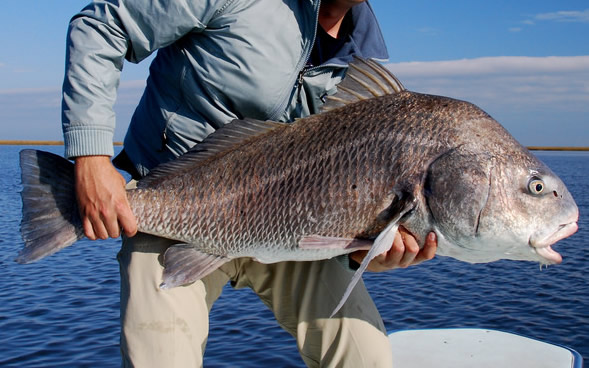The black drum is the largest member of the Sciaenidae family (drum and croaker). The common term “drum” refers to the loud and distinctive “drumming” noise that occurs when the fish raps a muscle against the swim bladder. This voluntary noise is assumed to be associated with locating and attracting mates, and it can sometimes be heard from a good distance, even by people above the water.
Identification
The black drum has a short, deep, and stocky body, with a high, arched back and a slightly concave tail. The lower jaw sports numerous barbels, or short whiskers. There are large pavementlike teeth in the throat, and the mouth is low. The dorsal fins have 11 spines, 20 to 22 dorsal rays, and 41 to 45 scales along the lateral line, which runs all the way to the end of the tail. Coloring is silvery with a brassy sheen and blackish fins, turning to dark gray after death.Size/Age
Average small drum weigh 5 to 10 pounds; large specimens commonly weigh 20 to 40 pounds. In Delaware Bay, fish from 40 to 70 pounds are fairly common in the spring. The all-tackle record is 113 pounds. Black drum live up to 35 years. |  |
Life history/Behavior
Black drum adults form schools and migrate in the spring to bay and river mouths for the spawning season; in the Gulf of Mexico this is from February to May. Larval black drum remain in shallow muddy waters until they are 4 to 5 inches long; then they move near shore.Food and feeding habits
Adult black drum feed on crustaceans and mollusks, with a preference for blue crabs, shedder crabs, shrimp, oysters, and squid. They locate food with their chin barbels and crush and grind shells with their pharyngeal teeth.Other Names
drum, sea drum, common drum, banded drum, butterfly drum, gray drum, striped drum, oyster drum, oyster cracker; French: grand tambour; Japanese: guchi, ishimochi, nibe; Portuguese: corvina; Spanish: corvinón negro, corbina, corvina negro, corvina, roncador. |
| Black Drum (Pogonias cromis) |
Distribution
Black drum are found in the western Atlantic Ocean, from Massachusetts to southern Florida and across the Gulf of Mexico to northern Mexico. They rarely occur north of New Jersey.Habitat
An inshore bottom fish, the black drum prefers sandy bottoms in salt or brackish waters near jetties, breakwaters, bridge and pier pilings, clam and oyster beds, channels, estuaries, bays, high marsh areas, and shorelines. Larger fish often favor shoal areas and channels.Black drum can survive wide ranges of salinity and temperature. The small fish inhabit brackish and freshwater habitats; the adults usually prefer estuaries in which salinity ranges from 9 to 26 parts per thousand and the temperature ranges from 53° to 91°F.
